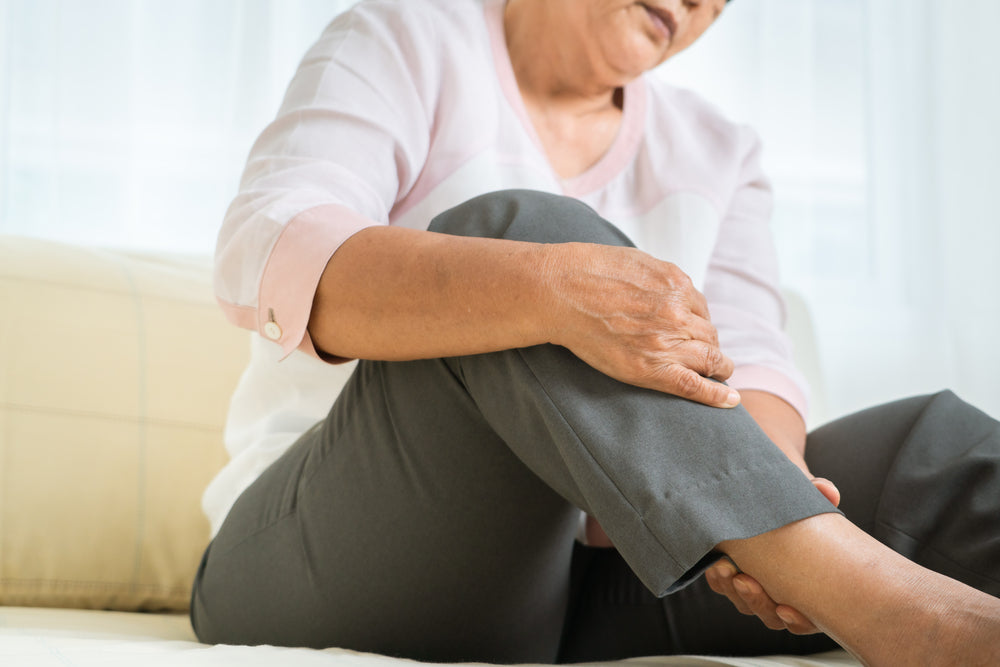Finding out whether restless leg syndrome (RLS) can cause leg cramps is a topic of interest for many.
Both medical conditions are widely characterized by widespread pain in our lower body muscles, with millions of people around the world dealing with them.
While there is not yet an established cause-and-effect relationship between both conditions, it's possible that restless leg syndrome can increase the likelihood of developing leg cramps.
But is that really the case? Are both conditions connected in some way, or is it just a coincidence?
To separate fact from fiction, that's what we'll be exploring in this article.
We'll explore the if restless legs syndrome can lead to leg cramps, as well as what you should do if you're suffering from the condition. You'll also discover a few lifestyle changes to consider that can help reduce the severity of RLS.
Let's begin!
Examining If Restless Leg Syndrome Can Cause Leg Cramps
So, can restless leg syndrome lead to leg cramps?
Well, giving a straight answer to this question is rather difficult, as there's no definite scientific evidence that suggests a direct link between the two conditions.
However, research has shown that patients experiencing restless leg symptoms are more susceptible to sudden leg cramps than those without the condition.
Let's explore just how leg cramps can occur as a result of restless leg syndrome.
How RLS leads to leg cramps
Restless legs syndrome is a neurological disorder that leads to uncomfortable and often painful sensations in the legs.
Also known as periodic limb movement disorder, it's largely caused by an imbalance of dopamine in the brain that leads to abnormal nerve firing. This, in turn, can lead to the involuntary movement of your legs.
With a strong urge to move your legs, it's possible that the muscles in the lower limbs may become overworked and fatigued, leading to leg cramps.
On top of this, those living with restless leg syndrome are more likely to be deprived of quality sleep due to their condition. This can lead to muscle fatigue as well as an increased likelihood of developing leg cramps.
If you're dealing with restless leg syndrome, finding relief is key to reducing the risk of developing leg cramps.
Let's explore a few simple steps you can take to achieve this in the next section.
How to Alleviate Restless Leg Syndrome from Causing Leg Cramps
Finding relief from restless leg syndrome is essential to reducing the risk of developing leg cramps.
But what steps can you take to achieve this?
Well, there are a number of treatments available that can help you find complete relief from the condition. These include lifestyle changes such as:
Regularly exercise
A simple yet effective way to relieve restless leg syndrome is to incorporate moderate exercise routines into your daily routine.
Regular exercise helps to increase blood circulation throughout the body, which can help alleviate uncomfortable sensations in the legs. It also helps to strengthen muscles and reduce fatigue, thus reducing the likelihood of developing leg cramps.
Aim to exercise for at least 30 minutes on most days of the week. This could include activities such as walking, jogging, swimming, or cycling.
You can also try yoga or stretching to help relax tense muscles and improve flexibility.
Practice yoga or meditation
Yoga and meditation are also excellent methods for finding relief from restless leg syndrome and leg cramps.
Both practices can help relax tense muscles, reduce stress levels, and improve flexibility. Yoga poses such as the bridge pose, child's pose, and seated forward bend can help stretch out tight muscles in the legs and relieve restricted blood flow.
Meditation helps to calm the mind and body, which can relieve sleep disorders and tension.
Get a massage

Getting a massage is also an excellent way to relieve the symptoms of restless leg syndrome.
Massages help to decrease systolic blood pressure circulation throughout the body, which can reduce uncomfortable sensations in the legs. It also helps to relax tense muscles and reduce fatigue, thus reducing the likelihood of developing leg cramps.
You can get a professional massage, or you could even try self-massage at home.
Yes, you heard that right.
Treating your legs to a massage in the comfort of your own home can be just as effective as getting a professional massage. Plus, you don't have to make a repetitive trip to the spa.
All you need is an oil or lotion and a high-end leg massager like the Fusion Air C Pro. This powerful massage tool works by utilizing air compression technology to deliver therapeutic massage pressure that can help soothe sore muscles and reduce the risk of developing leg cramps.
Other self-massage tools you can incorporate into your routine include foam rollers, massage sticks, and even tennis balls.
Take epsom salt baths
Third on our list of treatment options to relieve restless leg syndrome is soaking in epsom salt baths.
Epsom salt is rich in magnesium, which helps relax tense muscles and reduce inflammation. What's more, it helps to improve circulation and reduce muscle spasms, thus reducing the risk of developing leg cramps.
To make an epsom salt bath, simply dissolve 1-2 cups of epsom salt in a warm bath and soak for up to 20 minutes.
Apply warm packs
Making use of warm packs is another step you can take to relieve RLS
Applying a warm pack to the affected area can help relax tense muscles, thus providing complete relief from uncomfortable sensations. Furthermore, it increases blood circulation and helps reduce muscle spasms, which can in turn relieve restless legs symptoms.
It's important to note that heat sensitivity is common with restless legs syndrome, so always use a mild temperature when applying a warm pack.
Use a cold compress
Using a cold compress is another way to find relief from RLS.
A cold compress helps to numb the affected area and reduce any inflammation or leg pain that may be present. It also helps to relax tense muscles, thus leading to better nerve functioning.
To use a cold compress, simply wrap an ice pack or cloth filled with ice cubes in a towel and apply it to the affected area for up to 15 minutes. Repeat this process as needed until you find relief from the chronic condition.
Take prescription medications
If you are still dealing with restless leg syndrome, then you may want to consider taking medications like dopaminergic drugs or muscle relaxants.
Dopaminergic drugs help to balance dopamine levels in the brain, thus reducing the severity of the condition. On the other hand, muscle relaxants work by helping to reduce the involuntary muscle contractions and spasms that are associated with the condition.
Other proven treatments for restless leg syndrome include opioids, gabapentin, and bazinaprines.
Be sure to take medications as prescribed and never exceed the recommended dose. This way, you can help relieve leg muscle cramps.
By using any of these treatments, you can help reduce the risk of developing leg cramps due to restless legs syndrome. Just ensure that you are using the treatments as prescribed and stop taking them if any severe side effects occur.
Next, we'll look at some lifestyle changes you can make to help reduce the risk of developing leg cramps due to RLS.
Making Lifestyle Changes to Prevent Restless Leg Syndrome
Making lifestyle changes is a great way to help reduce the risk of developing restless leg syndrome and, consequently, leg cramps.
Here are some tips to get you started:
Get plenty of sleep
Do you know that sleep deprivation is a leading cause of RLS?
That's why it's essential to get enough rest when your body needs it.
Sleep plays an important role in reducing stress and restoring your body’s energy levels. When we don’t get enough restful sleep, it can cause our bodies to become tense and overworked, which makes it more likely for us to experience nocturnal leg cramps due to restless leg syndrome.
Make sure to get at least seven to eight hours of sleep every night. Also, try to avoid activities that can disrupt your sleep pattern, like drinking caffeine late in the day or working long hours.
This way, any case of nighttime leg cramps will be nothing but a distant memory.
Make sure your mattress and pillow are comfortable
One of the most important lifestyle changes you can make to help reduce the risk of developing restless legs symptoms is to ensure that your mattress and pillow are comfortable.
An uncomfortable mattress or pillow can not only cause restlessness at night, but it can also lead to muscle tension and leg cramps. So, make sure to invest in a good-quality mattress and pillow that will provide you with the support and comfort your body needs.
You'll also want to ensure that your mattress and pillow don't put too much pressure on your legs.
Avoid caffeine and alcohol
Staying away from caffeine and alcohol is another important lifestyle change you can make to help reduce periodic limb movements.
Both caffeine and alcohol are known to be stimulants, which can increase nerve activity and cause muscle tension. This, in turn, can lead to daytime or nighttime leg cramps. Therefore, it's best to avoid these substances as much as possible.
What's more, try to limit your intake of other stimulants, such as nicotine and certain energy drinks.
Eat iron and vitamin-rich foods

Eating foods that are rich in iron and vitamins can also help reduce the symptoms of restless leg syndrome.
Iron deficiency is a common cause of RLS, so it's important to make sure your diet is loaded with iron-rich foods such as spinach, lentils, and lean red meat.
In addition, eating foods that are rich in vitamins B6 and E can help reduce the risk of developing leg cramps due to restless leg syndrome. Such foods include fish, nuts, seeds, and dark leafy greens.
Just ensure that these foods are included in your daily diet to keep the severe symptoms of restless leg syndrome at bay. You may also take vitamin or iron supplements or other medications to treat restless leg syndrome.
Frequently Asked Questions
Get answers to a number of frequently asked questions we get about whether restless leg syndrome can cause leg cramps.
Feel free to reach out to any member of our team if you have any further questions.
How can I tell if I'm dealing with leg cramps from restless leg syndrome?
Leg cramps caused by restless leg syndrome are often characterized by a tingling or crawling sensation in the legs, which is usually accompanied by an irresistible urge to move them.
The cramps can also be accompanied by aching or burning sensations as well as severe pain. Other common side effects of restless leg syndrome include increased fatigue, difficulty concentrating, and periodic movements in sleep that cause insomnia.
If you have any of these symptoms or a combination of them, it is important to seek medical attention. Your health care provider can help you diagnose the condition and provide treatment options to manage periodic limb movements.
Besides restless leg syndrome, are there other medical conditions that can cause leg cramps?
While restless leg syndrome is one of the most common causes of leg cramps, there are certain medical conditions that can also be a primary cause.
For example, people with diabetes can suffer from nerve damage that can cause involuntary muscle contractions in the legs and feet, resulting in leg cramps. Other health conditions like deep vein thrombosis, kidney failure, blood clots, rheumatoid arthritis, and anemia can cause nutrient deficiencies that may contribute to leg cramping.
If you believe any of these conditions are contributing to your leg cramps, it is best to seek advice from your healthcare provider in regards to any of the risk factors we've discussed.
Can I experience restless leg syndrome and leg cramps simultaneously?
Yes, it is possible to experience both restless leg syndrome and leg cramps simultaneously.
This occurrence is more common in people who are prone to experiencing muscle spasms due to an underlying medical condition. It is also important to note that there may be other factors that can contribute to the development of both health conditions, such as stress, medications, pregnancy, and lifestyle habits.
If you think you have both conditions, it is best to seek medical help for further diagnosis and treatment.
Can I experience leg cramps without dealing with restless leg syndrome?
Yes, it is possible to experience leg cramps without dealing with restless leg syndrome.
Leg cramps can be caused by many other factors, such as muscle fatigue, dehydration, electrolyte imbalances, and even an underlying medical condition like varicose veins. It is important to take note of your lifestyle habits and if you are experiencing any new symptoms that may be related to leg cramping.
If you are unsure, it is best to seek medical help.
When should I seek medical help for restless leg syndrome?
Finding complete relief from RLS can be as easy as using a leg massager or getting a good quality of sleep.
However, if you are still experiencing significant symptoms even after a certain period of trying out different home remedies, then it is best to get medical help. You should seek medical help if the symptoms of RLS disrupt your daily activities or if they become worse over time.
Your physician can recommend more effective treatments and medications that can help you manage this common condition.
Conclusion
Hope this blog post has helped answer any questions you have about whether restless leg syndrome can cause leg cramps.
While it is possible to experience both conditions at the same time, it is important to note that there may be other underlying causes of leg cramps apart from RLS. Easy ways to find relief from restless leg syndrome include exercising regularly, consuming vitamin-rich foods, applying cold compresses, and getting massage therapy.
Self-massage tools like the Fusion Air C Pro leg massager give you the convenience of relieving restless leg syndrome anytime, anywhere. Plus, it's a one-time investment that you can enjoy for years to come.
Now that you know how to get complete relief from restless leg syndrome, make sure to take the necessary steps to prevent it from getting worse. This way, cases of leg cramps due to RLS can be managed and avoided.
Feel free to reach out to any of our team members if you have further questions. Our team is always happy to help!




